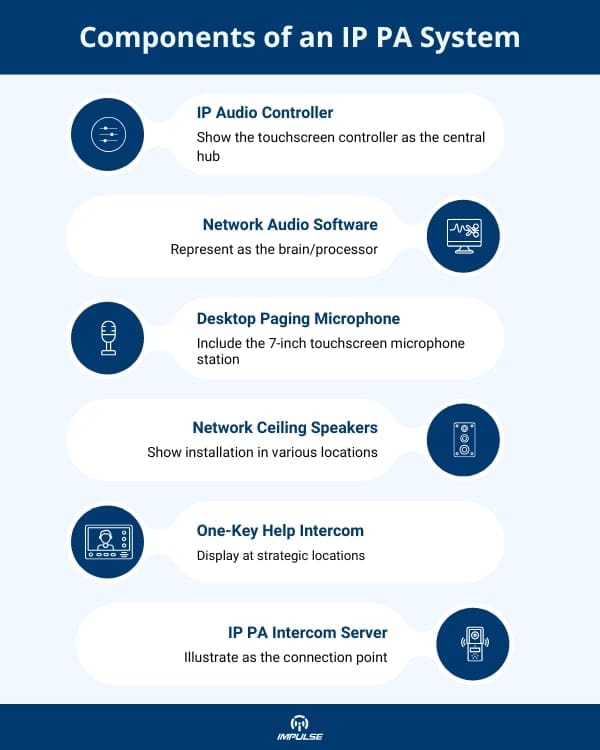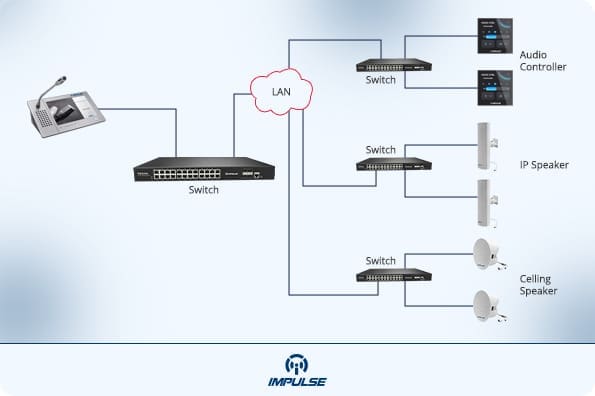Effective communication within buildings and across business premises has become a critical operational requirement. Traditional public address systems, while functional for decades, are increasingly unable to meet the demands of modern facilities. The digital transformation across industries has given rise to a new generation of communication solutions: IP-based Public Address (PA) Systems.
The Communication Challenge in Modern Facilities
Before diving into the solution, let’s understand the problem. Modern facilities whether they’re hospitals, corporate offices, educational institutions, or retail spaces face increasingly complex communication challenges:
- Emergency notifications need to reach everyone instantly
- Departmental communications require targeted messaging
- Staff members are constantly mobile across large facilities
- Building systems need to integrate seamlessly
- Communication must be reliable, even during power outages or emergencies
- Clear audio quality is essential for message comprehension
- Flexible communication options are needed for different situations
Traditional PA systems often struggle to meet these demands. They typically rely on analog technology, require extensive wiring, offer limited zoning capabilities, and function as standalone systems that don’t integrate well with other building technologies.
Enter the IP PA System: The Digital Communication Solution
An IP Public Address (PA) System represents the next evolution in communication technology. By leveraging Internet Protocol (IP) networking, these systems transform how businesses manage internal and external communications.

What Exactly is an IP PA System?
An IP-Based PA System is a communication solution that uses standard IP networks to transmit audio and control signals. Unlike traditional PA systems that require dedicated analog wiring, IP PA systems operate over the same network infrastructure that powers your computers, phones, and other networked devices.
At its core, an IP PA System consists of:
- IP Audio Controllers: The central management units that process and route audio signals
- Network Audio Software: The brain of the system that manages scheduling, zoning, and system operations
- IP Speakers: Network-connected speakers that receive and broadcast audio signals
- Intercom Terminals: Communication endpoints for two-way conversations
- Paging Stations: Microphones and control panels for making announcements
- Network Infrastructure: The existing Ethernet network that connects all components
How Does an IP PA System Work?
Understanding the mechanics of an IP PA System helps appreciate its advantages over traditional solutions:
1. Network-Based Communication
IP PA Systems leverage packet-switched networks rather than circuit-switched connections. Audio is digitized, compressed, and transmitted as data packets over the network. This approach offers several benefits:
- Scalability: Adding new speakers or zones is as simple as connecting them to the network
- Flexibility: Audio can be routed to specific zones or throughout the entire facility
- Quality: Digital transmission maintains audio clarity regardless of distance
- Integration: The system can easily connect with other IP-based systems
2. Power over Ethernet (PoE)
Most IP speakers and terminals are powered through the same Ethernet cable that carries data, eliminating the need for separate power supplies. This “Power over Ethernet” capability simplifies installation and improves reliability.
3. Intelligent Zoning
With IP PA Systems, creating and managing zones becomes a software function rather than a hardware limitation:
- Zones can be created, modified, or deleted through software
- A single speaker can belong to multiple zones simultaneously
- Zone configurations can change based on time of day or specific events
- Emergency broadcasts can override zone settings when necessary
4. Integration Capabilities
Perhaps the most powerful aspect of IP PA Systems is their ability to integrate with other building systems:
- Access Control: Automatically announce when secure doors are held open
- Fire Alarms: Trigger specific emergency messages based on alarm location
- Video Surveillance: Pair audio announcements with visual monitoring
- Building Management Systems: Coordinate with HVAC, lighting, and other building functions
- Telephone Systems: Allow announcements to be made from any phone
Key Components of an IP PA System
Let’s examine the essential components that make up a modern IP-Based PA System:
IP Audio Controller
The IP audio controller serves as the central hub of the system. Products like the audio controller from Impulse CCTV feature LCD touch screens for intuitive control and support multiple audio sources including server-based audio, local SD card content, and Bluetooth devices. These controllers can stream audio to specific zones with precise control over volume, scheduling, and priority.
Network PA Software
The software platform forms the nucleus of an IP PA System. Impulse CCTV’s IP Network Audio Software provides comprehensive management capabilities including scheduling automated announcements, managing user permissions, configuring zones and priorities, monitoring system status, integrating with other building systems, and recording and storing messages for future use.

Desktop Intercom Paging Microphone
Desktop intercom paging microphones provide a user-friendly interface with a 7-inch touch screen for making live announcements. These efficient stations boot up in less than a second and include built-in speakers for monitoring broadcasts. The system enables operators to select specific zones for broadcasts, make emergency announcements, monitor audio quality, access pre-recorded messages, and communicate with individual intercom terminals.
Network Active Ceiling Speakers
The network active ceiling speaker represents the modern approach to audio distribution. These speakers connect directly to the network via a single Ethernet cable, support Power over Ethernet (PoE), comply with international SIP protocols, offer wide sound diffusion angles, provide superior voice reproduction, and allow for easy installation in drop ceilings.

One-Key For Help Intercom Terminals
For emergency situations, the IMP-PAS-Intercom-Terminal-Series offers one-touch intercom terminals that provide immediate communication capabilities through a simple button press. These versatile devices can be strategically placed throughout a facility and connect directly to the network. Built with durability in mind, they feature weather-resistant designs for outdoor installation and include visual indicators to assist hearing-impaired individuals. The terminals support both audio and video communication, making them a comprehensive solution for emergency response systems.
IP PA Intercom Server
The IP PA Intercom-based System acts as the central integration platform that ties the entire system together. This powerful server connects LAN/WAN networks with PSTN and mobile networks while enabling comprehensive voice and video intercom functionality. It efficiently manages all broadcast functions across the network, delivers cost-effective communication through network convergence, and includes built-in redundancy support for mission-critical applications.
Benefits of IP PA Systems for Businesses
The shift to IP-Based PA Systems offers numerous advantages for modern businesses:
1. Cost Efficiency
- Reduced Infrastructure Requirements: Uses existing network infrastructure
- Lower Installation Costs: Requires less wiring and fewer connection points
- Decreased Maintenance Expenses: Centralized management and remote diagnostics
- Scalable Investment: Add components as needed without replacing the entire system
2. Enhanced Flexibility
- Easy Reconfiguration: Adapt the system as facility needs change
- Remote Management: Control the system from anywhere on the network
- Multiple Audio Sources: Incorporate various audio inputs from different locations
- Varied Broadcast Options: From all-call announcements to targeted messaging

3. Superior Performance
- Exceptional Audio Quality: Digital transmission maintains clarity
- Consistent Coverage: Eliminate dead zones with proper speaker placement
- Intelligent Prioritization: Ensure critical messages take precedence
- System Monitoring: Detect and address issues before they affect performance
4. Advanced Features
- Scheduled Announcements: Automate routine messages
- Text-to-Speech Capabilities: Convert written messages to spoken announcements
- Recording and Playback: Store announcements for future use
- Event Triggering: Automatically broadcast messages based on specific events
5. Smart Building Integration
For modern smart buildings, IP PA Systems serve as a critical communication backbone:
- Unified Communications: Integrate with VoIP telephone systems
- Emergency Response: Coordinate with fire alarms and security systems
- Occupant Experience: Enhance building usability with clear wayfinding and information
- Energy Management: Coordinate announcements with building occupancy
Implementing an IP PA System: Best Practices
- Assess Your Needs: Conduct a thorough evaluation of your facility’s communication requirements, including daily announcements, emergency protocols, and specific departmental needs. Consider factors like building layout, occupancy patterns, and noise levels.
- Evaluate Network Readiness: Perform a comprehensive network assessment to ensure your infrastructure can handle real-time audio transmission without compromising existing services. This includes checking bandwidth capacity, network switches, and Quality of Service (QoS) settings.
- Plan Speaker Placement: Work with acoustic experts to determine optimal speaker locations based on room dimensions, ceiling heights, and ambient noise levels. Consider factors like sound coverage overlap and potential echo points to ensure clear audio throughout the facility.
- Prioritize Security: Implement robust network security measures including encryption protocols, access control lists, and regular security audits to protect your PA system from unauthorized access or potential cyber threats.
- Consider Redundancy: Develop a comprehensive backup strategy including UPS systems, redundant network paths, and failover controllers to ensure continuous operation during power outages or network disruptions.
- Train Users: Develop a detailed training program for all staff members who will interact with the system, covering both routine operations and emergency procedures. Include regular refresher sessions and maintain updated documentation.
- Plan for Growth: Select a scalable system architecture that can accommodate future expansion, additional zones, and new features without requiring a complete overhaul. Consider future building additions or renovations in your planning.
Also Read: The Benefits of Integrating IP CCTV into Your Existing Network
Conclusion
As businesses continue to embrace digital transformation, IP Public Address Systems represent a critical component of modern facility management. By leveraging network infrastructure, these systems deliver superior flexibility, functionality, and value compared to traditional PA solutions.
The integration capabilities, enhanced audio quality, and advanced features of IP PA Systems make them ideal for smart buildings and forward-thinking organizations. From routine announcements to critical emergency communications, these systems ensure your message reaches the right people at the right time with crystal clarity.
Impulse CCTV offers comprehensive IP PA System solutions tailored to your specific needs. From initial assessment to installation and ongoing support, our team of experts ensures seamless implementation and optimal performance.


